Exams & Cleanings
The health of your child’s teeth and mouth is very important to the well-being of his or her entire body, and while routine brushing and flossing at home is necessary to keep your child’s smile looking its best, visiting the dentist for a comprehensive exam and cleaning is essential. The American Dental Association recommends that your child visit the dentist every six months to ensure his or her teeth stay healthy and smile stays beautiful.
By routinely seeing the dentist for exams and cleanings, your child can:
- Prevent tooth decay, gum disease, and bad breath
- Avoid costly and extensive dental procedures
- Have white teeth by reducing staining from food and drinks
- Shorten the time spent in the dentist’s office
- Have a smile that will last a lifetime
During your child’s exam, the dentist will thoroughly examine your child’s teeth and gums for signs of tooth decay, gum disease, and other health problems. The dentist may also want to take X-rays to see what is happening beneath the surface of the teeth and gums. Whether these X-rays are traditional or digital, the images provided will help the dentist discover dental issues not visible to the naked eye.
The dental hygienist will begin your child’s cleaning by exploring the surface of the teeth to determine if there are any cavities and to examine the quality of existing fillings. The hygienist will clean and then the dentists will go from there.
Cleanings usually aren’t painful, but if your child has any anxiety about the dental exam, be sure to let the hygienist know. They may offer several sedation options to ensure your child’s comfort. If the dentist or hygienist finds tooth decay or gum disease, they will talk to you about changing your child’s brushing or flossing habits. In severe cases, they may recommend antibiotics or other pediatric dental treatments. If your child’s teeth and gums appear to be healthy, the dentist will probably recommend that your child continue his or her brushing and flossing routine as usual.
Prophylaxis
Prophylaxis, commonly known as a professional dental cleaning, is a foundational aspect of pediatric dental care. We emphasize the importance of regular prophylaxis to ensure that your child’s oral health remains in top condition. This preventive measure involves the careful removal of plaque and tartar build-up, which are primary culprits behind tooth decay and gum disease.
During a prophylaxis appointment, our skilled dental hygienists will clean your child’s teeth thoroughly, removing any hardened deposits that brushing and flossing at home might miss. This process not only helps in maintaining a bright smile but also plays a crucial role in preventing cavities and other dental issues. The cleaning is followed by polishing the teeth to remove surface stains and make it more difficult for plaque to adhere to the enamel.
In addition to the mechanical cleaning, our dental team will conduct a thorough examination of your child’s mouth. This allows us to identify early signs of potential problems and provide timely interventions. We also take this opportunity to educate both children and their parents about effective oral hygiene practices, reinforcing the importance of daily brushing, flossing, and healthy dietary choices.

Nutrition & Oral Health
Establishing good nutritional habits for your child can be especially beneficial to promote good eating patterns and food choices for the rest of his or her life. Think of your child’s mouth as the doorway to the rest of the body. Whatever gets consumed not only affects your child’s growth, development, weight, and energy levels, but oral health as well. Eating a nutritious, balanced diet is vital for the development of strong, healthy teeth.
General Tips For A Healthy Diet & Smile
- Limit your child’s consumption of sugary foods and beverages. When plaque combines with the sugars and starches, an acid is produced that attacks enamel on the teeth, and eventually causes decay.
- Make sure your child’s diet includes a balance of fruits and vegetables, whole grains, protein, and dairy products. The nutrients found in these foods are important to his or her growth and health.
- Look for sugar in unexpected places. Many foods that make up a balanced, healthy diet contain sugar — including fruit, some vegetables, and milk.
- When he or she is old enough, let your child chew sugar-free gum that carries the ADA seal. Chewing sugar-free gum increases saliva flow, which washes away food debris and neutralizes acids produced by bacteria.
- Ensure your child brushes twice a day and flosses to eliminate food debris that leads to harmful plaque and bacteria, and causes tooth decay.
Preventative Hygiene
Preventive dental care is important throughout life, especially at a young age. By practicing good oral hygiene at home and scheduling regular checkups with the dentist, your child can help keep their smile bright and healthy for many years to come. Here are a few simple ways to prevent the build-up of plaque and cavities:
- Make sure your child brushes their teeth at least twice a day with a soft-bristled toothbrush. Use fluoride toothpaste to remove food particles and plaque from the tooth surfaces. Also, be sure your child brushes the top surface of the tongue; this will remove any extra plaque-causing food particles and help keep their breath fresh!
- Make sure your child cleans between teeth by flossing at least once a day. You can also use a mouthwash to help kill bacteria and freshen breath. Decay-causing bacteria can linger between teeth where toothbrush bristles can’t reach. Floss and mouthwash will help remove plaque and food particles from between the teeth and under the gum line.
- Make sure your child eats a balanced diet, and try to avoid extra-sugary treats. Nutritious foods such as raw vegetables, plain yogurt, cheese, or fruit can help keep your child’s smile healthy.
- Remember to schedule regular checkups with your child’s dentist every six months for a professional teeth cleaning.
- Ask your dentist about dental sealants, a protective plastic coating that can be applied to the chewing surfaces of the back teeth where decay often starts.
- If your child plays sports, be sure to ask your dentist about special mouthguards designed to protect your child’s smile.
For more detailed instructions on best practices for brushing and flossing, check out our printable guides here.
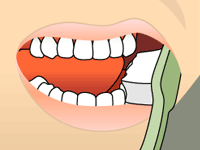
Step 1
Place your toothbrush at a 45-degree angle to your gum.
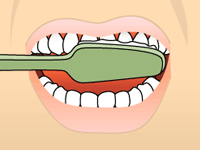
Step 2
Brush gently in a circular motion.

Step 3
Brush the outer, inner, and chewing surfaces of each tooth.
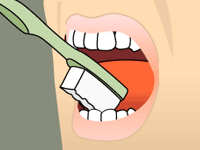
Step 4
Use the tip of your brush for the inner surface of your front teeth.
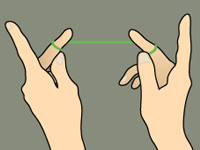
Step 1
Wind about 18 inches of floss around your fingers as shown. Most of it should be wrapped around one finger, and the other finger takes it up as the floss is used.
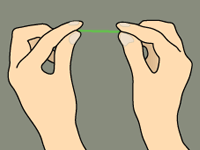
Step 2
Brush gently in a circular motion. Use your thumbs and forefingers to guide about one inch of floss between your teeth.
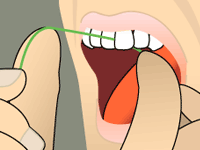
Step 3
Holding the floss tightly, gently saw it between your teeth. Then curve the floss into a C-shape against one tooth and gently slide it beneath your gums.
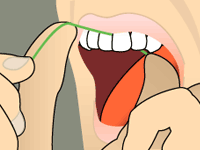
Step 4
Slide the floss up and down, repeating for each tooth.
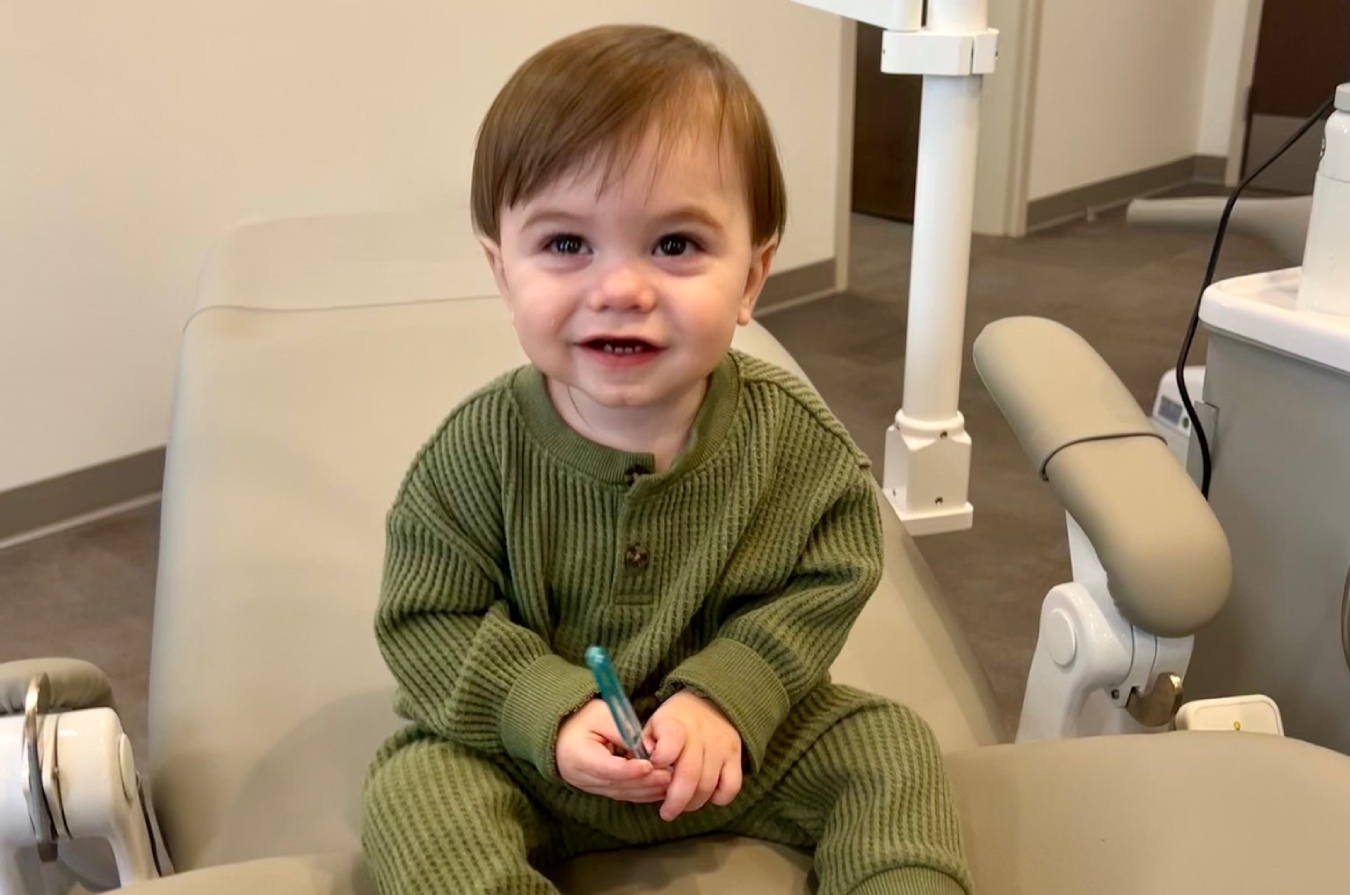
Dental Care For Your Baby
Congratulations on the arrival of your baby! Are you prepared for the arrival of your baby’s first tooth? Follow these guidelines and your son or daughter will be on the way to a lifetime of healthy smiles!
Caring For Gums
Even before your baby’s first tooth appears, the gums can benefit from your careful attention. After breast- or bottle-feeding, wrap one finger with a clean, damp washcloth or piece of gauze and gently rub it across your baby’s gum tissue. This practice both clears your little one’s mouth of any fragments of food and begins the process for building good daily oral care habits.
Baby’s First Teeth
When that first tooth makes an entrance, it’s time to upgrade to a baby toothbrush. There are usually two options: a long-handled toothbrush that you and your baby can hold at the same time, and a finger-puppet-like brush that fits over the tip of your pointer finger. In each case, the bristles are soft and few.
At this stage, toothpaste isn’t necessary; just dip the brush in water before brushing. If your little one doesn’t react well to the introduction of a toothbrush, don’t give up. Switch back to a damp washcloth for a few months and try the toothbrush again. During the teething process, your child will want to chew on just about anything, and a baby toothbrush with a teether can become a favorite toy during this period.
When a few more teeth appear, you can start using toothpaste with your child’s brush. At this stage, use only a tiny amount of fluoridated toothpaste (the size of a grain of rice). From the beginning, have your little one practice spitting the toothpaste out after brushing, which should not be swallowed at any age.
Don’t give your baby any sort of sweetened liquids such as flavored drinks or soda. Even the sugars present in fruit juice, formula, and milk (this goes for breast milk as well) can cause decay, so regular teeth and gum cleaning is vital. Also, make sure your baby never goes to bed with a bottle; sugary liquids in prolonged contact with teeth are a guarantee for early-childhood decay, also called baby-bottle caries.
First Visit To The Dentist
It’s recommended that you bring your baby in for a visit within six months of the first tooth’s eruption — usually around his or her first birthday. Since decay can occur in even the smallest of teeth, the earlier your baby visits us, the more likely he or she is to avoid problems. We’ll look for any signs of early problems with your baby’s oral heath, and check in with you about the best way to care for your little one’s teeth. Remember that preparing for each dental visit with a positive attitude goes a long way toward making your child comfortable with regular checkups.
Setting A Good Example
As part of the natural learning process, little ones are expert mimics, and you can take advantage of this talent. Brush and floss daily while your child is watching, and he or she will intuit at an early age the importance of your good habits. As soon as your child shows interest, offer a toothbrush of his or her own and encourage your toddler to “brush” with you. (You’ll find toothbrushes with chunky, short handles that are easy to grip.) Most children don’t have the dexterity necessary to thoroughly clean their own teeth until they’re about six or seven, so you’ll have to do that part of the job. Try different tactics to make brushing fun: flavored toothpaste, a toothbrush with a favorite character on it, or singing songs about brushing. The primary goal is to instill healthy oral habits at an early age to set your child up for a lifetime of healthy, cavity-free teeth!
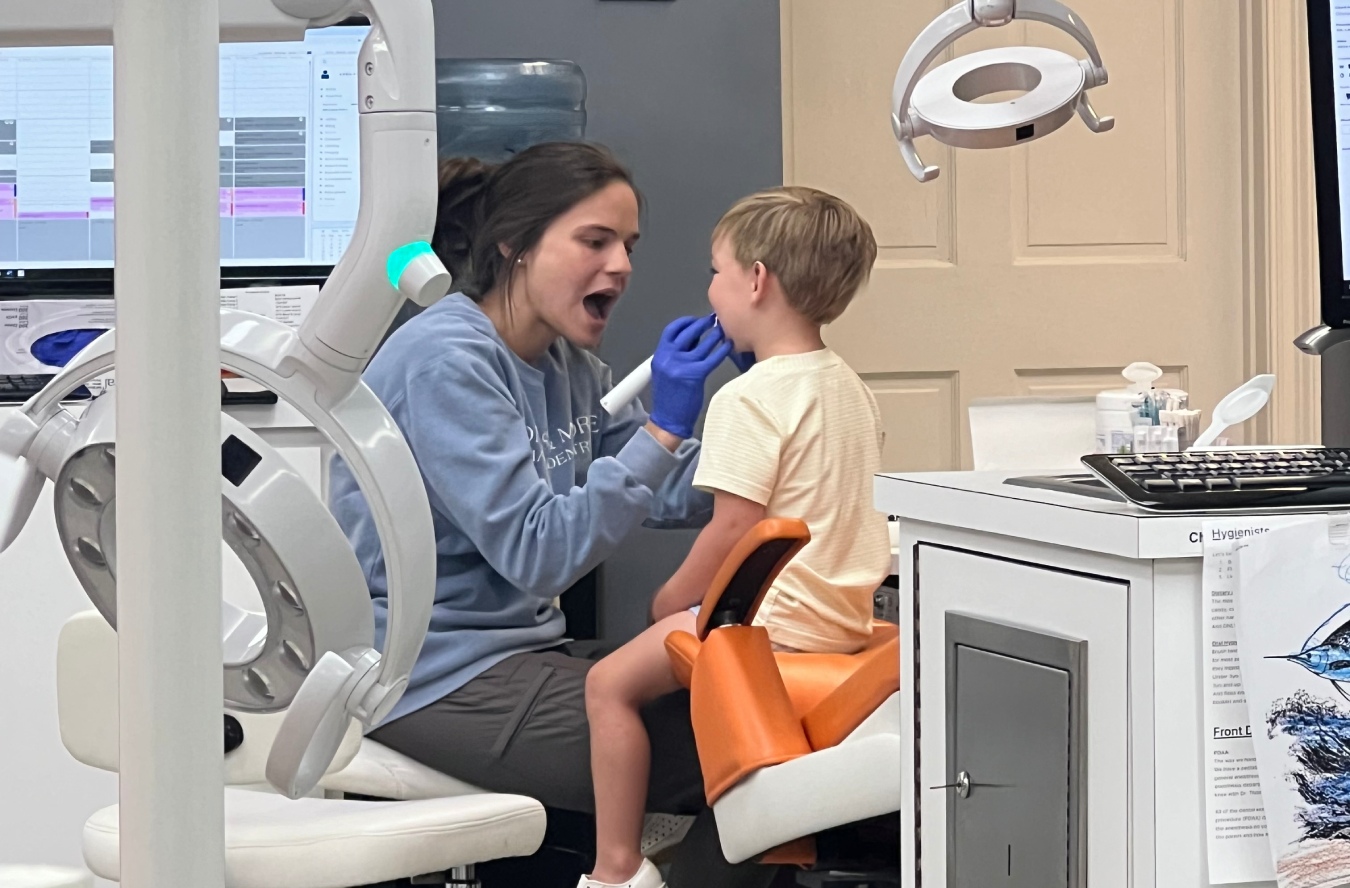
Sealants
Sometimes brushing is not enough, especially when it comes to those hard-to-reach spots in your child’s mouth. It is difficult for a toothbrush to reach between the small cracks and grooves on teeth. If left alone, those tiny areas can develop tooth decay. Sealants give your child’s teeth extra protection against decay and help prevent cavities.
Dental sealants are plastic resins that bond and harden in the deep grooves on the tooth’s surface. When a tooth is sealed, the tiny grooves become smooth, and are less likely to harbor plaque. With sealants, brushing becomes easier and more effective against tooth decay.
Sealants are typically applied to children’s teeth after their permanent teeth have erupted as a preventive measure against tooth decay. It is more common to seal “permanent” teeth rather than “baby” teeth, but every patient has unique needs, and the dentist will recommend sealants on a case-by-case basis.
Sealants last from three to five years, although it is fairly common to see adults with sealants still intact from childhood. A dental sealant only provides protection when it is fully intact so if your child’s sealants come off, let the dentist know, and schedule an appointment for your child’s teeth to be re-sealed.
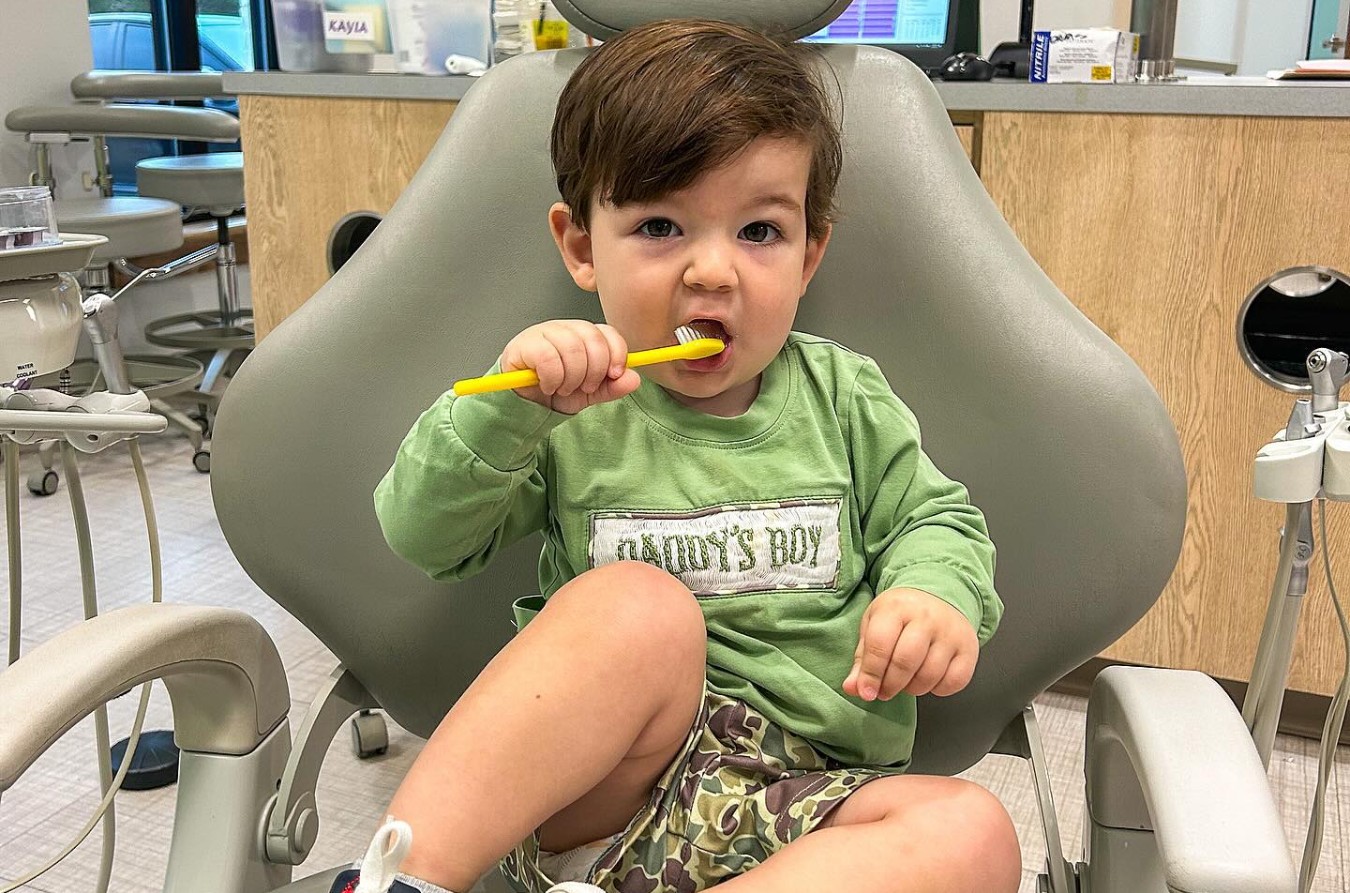
Fluoride
Your child brushes twice a day, flosses regularly, and visits the dentist every six months. But did you know that rinsing with fluoride — a mineral that helps prevent cavities and tooth decay — also helps keep teeth healthy and strong?
Fluoride is effective in preventing cavities and tooth decay by coating teeth and preventing plaque from building up and hardening on the tooth’s surface.
Fluoride comes in two varieties, systemic and topical:
- Systemic fluoride is ingested, usually through a public water supply. While teeth are forming under the gums, the fluoride strengthens tooth enamel, making it stronger and more resistant to cavities.
- Fluoride can also be applied topically to help prevent caries (cavities) on teeth present in the mouth. It is delivered through toothpaste, mouthwash, and professional fluoride applications. Professional application of topical fluoride foam and varnishes is also a valuable tool in cavity prevention.
A fluoride treatment in the pediatric dentist’s office takes just a few minutes. After the treatment, patients may be asked not rinse, eat, or drink for at least 30 minutes in order to allow the teeth to absorb the fluoride. Depending on your child’s oral health or your doctor’s recommendation, your child may be required to have a fluoride treatment every three, six, or 12 months. Your doctor may also prescribe at-home fluoride products such as mouthwash, gels, or antibacterial rinses.
When choosing an at-home fluoride product (such as toothpaste or mouthwash), always check for the American Dental Association’s (ADA) seal of acceptance. Products marked with the ADA seal of approval have been carefully examined and approved by the ADA based on safety and effectiveness.

Silver Diamine Fluoride (SDF)
At Thomas & Moore Pediatric Dentistry, we are dedicated to offering innovative and effective dental treatments for kids. One such treatment is Silver Diamine Fluoride (SDF), a minimally invasive option to combat tooth decay. SDF is particularly beneficial for children who may be anxious about dental procedures or those who have special healthcare needs.
Silver Diamine Fluoride is a liquid that can be easily applied to the affected areas of your child’s teeth. It works by stopping the progression of cavities and preventing new ones from forming. The silver component kills bacteria, while the fluoride helps to remineralize the tooth structure, making it stronger and more resistant to future decay.
One of the key advantages of SDF is its non-invasive nature. Unlike traditional cavity treatments that require drilling and filling, SDF can be applied quickly and painlessly. This makes it an excellent choice for young children or those who might find conventional dental procedures challenging. Additionally, SDF serves as an interim solution for treating cavities until more definitive restorative work can be performed.
It’s important to note that while SDF is highly effective, it does cause treated areas to turn a dark color. This discoloration is a sign that the treatment is working, as it indicates the arrest of decay. Our team ensures that parents and children are fully informed about what to expect before proceeding with SDF treatment.